Japan
Wood Products Prices
Dollar Exchange Rates of 10th
May
2022
Japan Yen 130.0
Reports From Japan
Companies concerned about the
weakening yen
A Kyodo News survey found almost all major companies
in the country are concerned about the weakening yen
despite this generally benefitting exporters. The yen has
shed around 15% against the US dollar since March and
dropped to a 20-year low.
The Governor of the Bank of Japan maintains that the
positive effects of a weak yen outweigh the negative and
the Bank will continue its easy monetary policy. This
could drive the yen down further. Households are feeling
the strain of a weak yen as the cost of imports, especially
energy, are rising fast.
The government will fund subsidies and other measures
aimed at cushioning the economic impact from rising fuel
and raw material prices.
The record low yen would encourage inbound tourism and
have a positive impact on the economy but only recently
has the government indicated it is considering lifting the
border closure to tourists.
It has been observed that the border closures late last year
failed to prevent a domestic outbreak calling into question
the scientific rationale for continued border restrictions.
See:
https://mainichi.jp/english/articles/20220502/p2g/00m/0bu/053000c
and
https://www.eastasiaforum.org/2022/05/05/depreciating-yenthreatens-japans-economy/
and
https://thediplomat.com/2022/05/whats-behind-japans-continuedcovid-19-border-restrictions/
Private sector continues call for easing travel
restrictions
Japan¡¯s economy is at risk of shrinking again due to the
spread of covid variants and because of rising food and
fuel prices which are driving down consumer spending.
In pre-pandemic days the weak yen would have attracted
international tourists but the border restrictions have shut
the door to tourism income.
The government¡¯s reluctance to reopen the border to
tourists has to take account of public opinion because the
common view is that foreigners bring covid. However,
Japan is likely to remove border controls in June bringing
Japan in-line with other G7 countries.
The infection situation has been stabilising in Japan and
the Prime Minister has said his government will consult
with public health experts before easing the entry of
tourists. The private sector has been calling for easing
travel restrictions and members of a Japanese government
panel recommended entry controls should be normalized
as soon as possible.
Business index trends positive
A major index on business sentiment which is said to
gauge the direction of the overall economy rose in March
for the second consecutive month driven higher by activity
in the retail and services sectors.
In light of this positive news the Cabinet Office
maintained its assessment that the economy is
"improving".
The latest data showed the index for business conditions
which is interpreted as the likely situation in the coming
months rose in March, the first time increase in three
months.
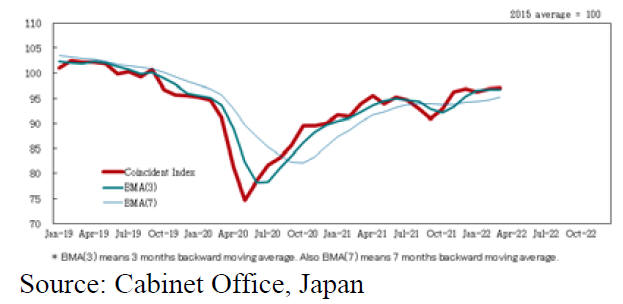
Look no hands - autonomous container ship
trial
The Nippon Foundation has announced it successfully
deployed an autonomous container ship on a 790-
kilometre round-trip between Tokyo Bay and a port in Mie
Prefecture. The Foundation says that it is the first time that
such a voyage has been attempted and this was a
comprehensive trial complete with sea-to-ground
communication links.
See:
https://www.nippon.com/en/japan-topics/g02078/
Dive in consumer confidence flattens out
Japan¡¯s consumer confidence index reversed course in
April and rose, the first rise in six months and came as the
Covid-19 restrictions were lifted. Despite the postive turn
the index is well below what it was at the end of 2021.
The consumer confidence survey found almost all
consumers expect prices of goods to rise in the next 12
months. In this they are correct as price increase for food
and fuel has been noticeable. The government recently
increased its fuel subsidy.
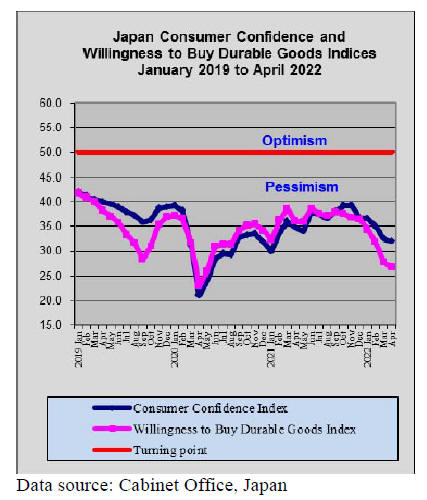
Population declines for 11th year
A report from the Ministry of Internal Affairs and
Communications shows that Japan¡¯s population as of 1
October 2021 was 125,502,000. This was a drop of
644,000 from the previous year the largest decline since
1950. This was the eleventh consecutive year that the
population declined.
See:
https://www.nippon.com/en/japandata/h01310/?cx_recs_click=true
Japanese homebuyers supporting overseas timber
businesses
Unlike other countries homes in Japan become nearly
valueless after 20-30 years. If someone moves out of
a home before that period the house is considered as
having no value and is demolished to release the value of
the land which is seen as being high value.
This approach to home building has been explained by the
historic rush to rebuild after the second world war where
little attention was paid to longevity and also the
frequently changes to the building codes to improve quake
resistance. With most of the timber used in home building
being imported it is the overseas timber suppliers who
benefit most from Japanese home replacement.
See:https://www.archdaily.com/980830/built-to-not-last-thejapanese-trend-of-replacing-homes-every-30-years
Error detected in construction order data
Japanese experts are studying the government's
compilation of construction order data. The experts
estimate that statisticians in the Ministry of Land,
Infrastructure, Transport and Tourism inadvertently
inflated the order values by almost US$40 billion annually
for the past eight years as a result of a double counting
error. The data is a component of Japan's gross domestic
product.
See:
https://www3.nhk.or.jp/nhkworld/en/news/20220513_31/
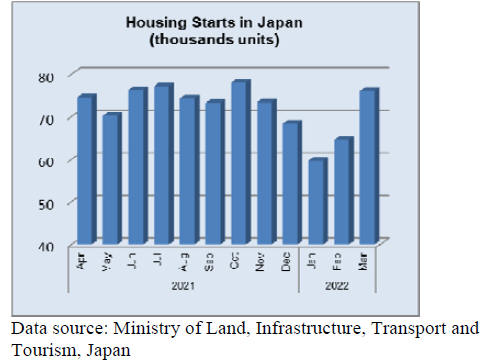
Yen
The yen¡¯s decline against the US dollar over the past two
months has ended as concerns over a slowdown in China¡¯s
growth and the likely negative impact of interest rate
increases in the US make the yen attractive as a safehaven.
The yen gained to 128 to the US dollar mid-month
after falling below 130.
See:https://www.japantimes.co.jp/news/2022/05/13/business/yen-freefall-dollar-over/

Furniture imports
The covid-19 pandemic disrupted furniture imports but the
impact was short lived. Looking at the trend in the value
of imports of wooden office, kitchen and bedroom
furniture from 2019 to 2021 there was a dip in the value of
imports in early 2020 but the recovery took hold very
quickly. Clearly consumer purchases of furniture contined
which mirrors the recovery in consumer willingess to
purchase durable goods (see consumer confidence index
above).
In response to the spread of infection the government
imposed lockdowns which restricted travel, eating out and
entertainment which resulted in consumers turning to
improvements at home including furniture replacement.
The office furniture segment got a boost from the move to
remote working as people needed office work space and
office furniture for the home.
This sector also got a boost in sales as companies adapted
to the need for social distancing and invested in ¡®tele-work
cubes¡¯ designed for a single occupant. The combined
demand for tele-work and secure work cubicles among
others meant demand for imported office furniture
recovered and expanded in late 2020 and 2021.
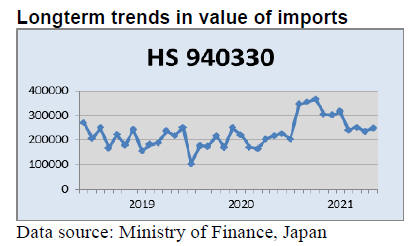 
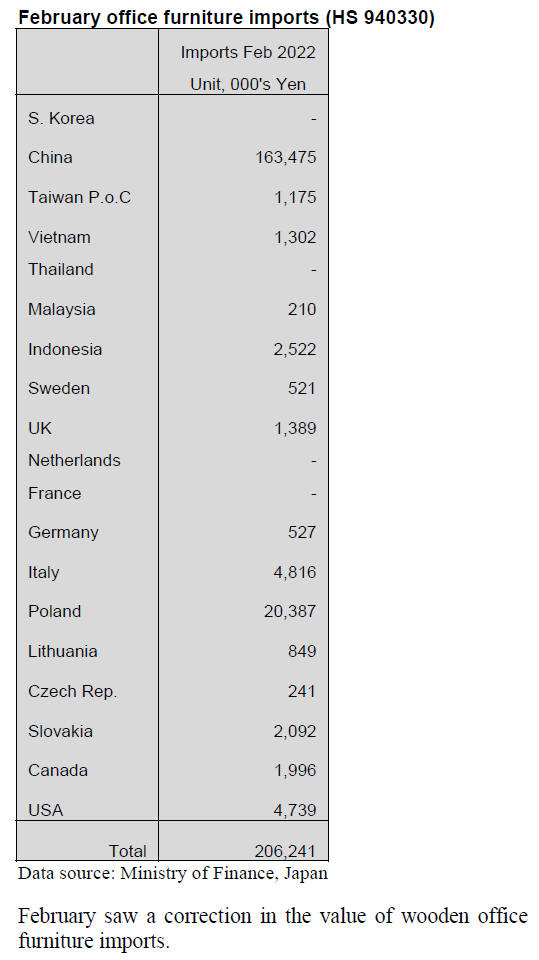
Year on year the value of imports of wooden office
furniture (HS940330) were largely unchanged but there
was a 35% downward correction in the value of February
imports compared to a month earlier.
February kitchen furniture imports (HS 940340)
After two consecutive months of decline the value of
Japan¡¯s imports of wooden kitchen furniture (HS 940340)
rose around 5% in February and there wes a 6% increase
in the value of imports compare to February 2021. There
were two major shippers of wooden kitchen furniture in
February, the Philippines and Vietnam.
Shipments from the Philippines were up on Janauary and
accounted for 47% of all wooden kitchen furniture imports
in February. Shipments from Vietnam accounted for 36%
of wooden kitchen furniture imports but were flat
compared to a month earlier. China was the third ranked
shipper of wooden kitchen furniture in February
accounting for 8% of imports.
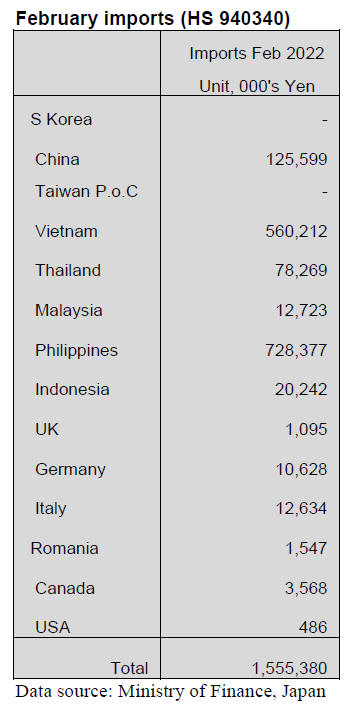
February bedroom furniture imports (HS
940350)
After the record high value of wooden bedroom furniture
imports seen in January this year there was a correction in
February but still the total value was very high compared
to the average over the past 12 months.
China was the main supplier of wooden bedroom furniture
in February accounting for 54% of the value of imports of
HS 940350 but this was down from the over 60% in
January this year. The second ranked shipper in terms of
import value was Vietnam at 37% and this was an
improvement on the value of January imports.
Shippers in Malaysia continue to be ranked third in terms
of shipment values at around 3%.
Year on year, February 2022 imports were flat but month
on month February imports were down 7%.

Trade news from the Japan Lumber Reports (JLR)
The Japan Lumber Reports (JLR), a subscription trade
journal published every two weeks in English, is
generously allowing the ITTO Tropical Timber Market
Report to reproduce news on the Japanese market
precisely as it appears in the JLR.
For the JLR report please see:
https://jfpj.jp/japan_lumber_reports/
Confusing Russian lumber business
There are so many disrupting factors of Russian lumber
trade. The Japanese government has not banned import of
Russian lumber but many Japanese trading firms have
started curbing Russian lumber business since
environment of trading with Russia has been confusing.
One (Japanese shipping line) is transportation of
lumber
from Siberian sawmills to loading ports. Availability of
rail car containers is very tight and even if containers
become available, rail car transportation system is not
working smoothly.
Even if lumber is railed to loading ports like Nakvodka
and Vradiostock there is no guarantee to tie-up with ocean
going vessels to Japan after major container shipping
companies like Maersk line stopped calling Russian ports
and the Japanese container shipping company ¡®One¡¯
decided to stop calling at Russian ports so only available
line is Russian shipping company of Fesco but available
containers Fesco has is very limited.
If the cargo is diverted to other countries ports like
Dalien, Chingtao and Shangahai of China or Busan of
Korea it is very difficult to pin point arrival time to Japan.
Also price of container including Siberian rail climbed to
US$1,000 (US$20 per cbm).
Another problem is payment. Normally payment is made
when lumber is loaded on rail cars but now even if rail car
arrives loading port, lumber may be left in the yard for
indefinite period without any ship to load so for buyers, it
is safe to make payment on FOB ship basis rather than CIF
but for lumber suppliers, quick payment is necessary since
their financial condition does not allow time consuming
payment. Also banking system in Russia is confusing after
major Russian banks are excluded from SWIFT system so
international trade system in Russia is now very limited.
Further trade restrictions may be imposed by the
government so everybody thinks it is safe to minimize
business with Russia.
In 2021, import of Russian lumber was 851,000 cbms. It
has been over 800 M cbms since 2016 so the market in
Japan has this much demand for Russian lumber. Some
companies have special connection with Russian partners
like Tairiku Trading, which has exclusive right to handle
Leslisurus and TM Baikal, which is run by Tajima Lumber
plan to continue steady business to guarantee stable supply
of Russian lumber.
Change of import duty on Russian products
After the government cancelled the most-favored-nation
treatment for Russia, import duty of Russian products is
changed. Import duty of red pine and whitewood lumber is
8% from 4.8%, spruce lumber is 6% from 4.8%, larch
lumber is 10% from 6%.
Duty on structural laminated lumber and semi-finished
product of red pine and redwood is unchanged at 3.9% and
4.8%. Laminated stud duty is raised from 6% to 15%.
Prior to this announcement, import of Russian veneer,
wood chip and logs is banned
Plywood
Domestic and imported plywood are very tight supply and
the prices have been rising. Especially, domestic softwood
plywood will be a short supply.
Usually, the inventory is full in March but pre-cutting
companies delayed working so the shipment is not good.
Production depends on availability of workers, the supply
of logs and a number of working days.
There are holidays at the end of April through May and
plywood companies in Eastern Japan have been stop
operating a week before the holiday due to maintenance of
equipment. So, there is a possibility of a smaller
production in April and May.
There is another problem that there is no Russian veneer
available anymore. Plywood companies in Japan tried to
use domestic cedar or domestic larch as substitution.
South Sea hardwood plywood companies in South East
Asia do not accept many new contracts due to lack of logs.
Japanese companies take a lot of higher importing cost
because the logs are high-priced, the minimum wages in
Malaysia have increased and a weak yen hit the dollar.
There are many inquiries for structural plywood to replace
tight supplied domestic softwood plywood.
Domestic logs and lumber
Log production in April was steady so that log auction
markets, sawmills are loaded with full of logs. Log supply
tightened and the prices soared last year but there is no
such supply shortage this year.
Normally winter harvest is over and sawmills shy away
purchasing of spring harvest logs as log quality
deteriorates with more moisture, which causes blue stain
so log prices would keep skidding toward summer but this
year, plywood demand is far stronger by supply disruption
of Russian larch veneer so there is not surplus of logs this
year.
Log prices are firming all over Japan as plywood mills¡¯
aggressive purchase pushes the prices up. In particular,
orders for pine and larch are very strong. Cedar log prices
soared to 16,000-18,000 yen to substitute Russian wood so
that orders of non-structural lumber are increasing.
Cypress log prices had been sliding but finally stopped by
strong demand of plywood mills so the now the prices are
leveling off at about 25,000 yen.
Substituting demand to cedar non-structural lumber started
in Tokyo region after Russian invasion to Substituting
demand of Russian red pine taruki to cedar ceiling joist
and of European whitewood stud to cedar stud. Supported
by this move, the prices of cedar post and cypress sill
stopped sliding.
Market prices of KD cedar stud (30x105 mm) are 90,000-
100,000 yen and KD cedar post (105 mm square) are
100,000-110,000 yen. Sawmills try to push the prices
further up because of higher log cost. Sudden demand
increase of cedar stud seems to be speculative move to buy
lower cost cedar stud now.
Increasing prices of imported hardwood
plywood
Despite continuous climbing suppliers¡¯ export prices,
market of imported hardwood plywood has been
stagnating and the prices are slow to move up in Japan.
Circumstances changed all at once after Russian invasion
to Ukraine and sudden depreciation of the yen since late
March.
Supply of Russian larch veneer is totally stopped so that
domestic plywood supply gets tight by supply disruption
of Russian veneer.
Demand for imported hardwood structural plywood gets
stronger and the market prices are more than 2,000 yen per
sheet, more than 100 yen up from April in Tokyo market.
Market prices of concrete forming panel moved up to
2,000 yen. It was less than 1,800 yen before March then
finally moved up to 1,900 yen in March.
April export prices are US$830-840 per cbm C&F on JAS
3x6 concrete forming panel and structural panel prices are
aboutUS $790, more than US$20 up from March.
The suppliers say that log supply is tight and labor cost is
up by higher minimum wage in Malaysia and they see that
worldwide wood supply is likely to get tight after Ukraine
dispute so the export prices will definitely be higher then
meantime yen¡¯s exchange rate changed drastically from
115 yen per dollar to 130 yen so the dealers in Japan have
no choice but to increase the sales prices.
Future cost of concrete forming panel is 2,300 yen, which
will arrive in July and August so present 2,000 yen is way
below cost.
A price hike of domestic softwood plywood
Plywood companies in Eastern and Western Japan decided
to raise the prices of 3 x 6 of 12mm as of May 1. It will be
1,900 yen per sheet delivered and this is 100 yen up from
April. It will be 95,000 yen as per cbm and this is 5,000
yen more than last month. The manufacturers had no other
choices but to raise the prices.
The prices of 3 x 6 of 24mm will be 3,800 yen delivered
and 3 x 6 of 28mm will be 4,450 yen. These are 250 yen
up from last month.
The prices of logs keep increasing. Western larch 4 meters
logs cost 30,000 yen as per cbm arriving at plant. This is
over 3,000 yen up from April. One of reasons for price
hike is that there is no more larch veneer supply from
Russia. There are not enough Douglas fir logs either.
Some plywood companies started to use cedar to substitute
Douglas fir. In the North East, cedar logs cost 15,000 ¨C
17,000 yen arriving at wholesaler. This is steady but the
prices might go up because there is demand for cedar logs
by other users like sawmill and laminated lumber mill.
The prices of crude oil and natural gas are soaring and a
weak yen hits the dollar, so the glue prices are also
increasing.
There is much demand of plywood but plywood
companies are not able to produce enough to satisfy the
demand even though the workers have been in full
operation.
The reasons are that there was a long holiday at the end of
April through May and there was a regular inspection at
plants before the holiday. Some plywood companies took
a holiday a week earlier.
|